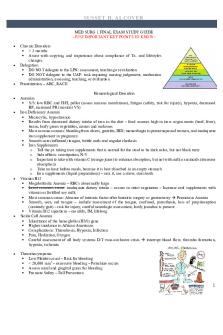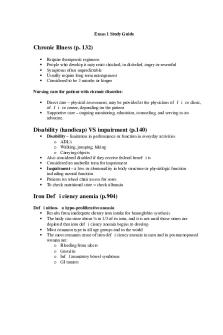Med surg 1 case study renal PDF

| Title | Med surg 1 case study renal |
|---|---|
| Author | tzipporah gabaie |
| Course | Med-surg |
| Institution | Baltimore City Community College |
| Pages | 3 |
| File Size | 96.2 KB |
| File Type | |
| Total Downloads | 76 |
| Total Views | 160 |
Summary
case studies for professor bass...
Description
Tzipporah Gabaie Med Surg 1 Professor Bass 3/8/2021
Case Study Renal N.G. is a 21-year-old college student who is admitted to the hospital with a diagnosis of acute poststreptococcal glomerulonephritis. He was seen at the college's student health center because of swelling around his eyes and rusty-colored urine. His history based on medical records from the student health center indicates that he had a sore throat several weeks ago that he ignored because it resolved in 4 to 5 days. His past medical history is positive for type 1 diabetes mellitus since the age of 7. However, he has maintained excellent control of his serum glucose levels via intensive insulin therapy. His history based on medical records from the student health center indicates that he had a sore throat several weeks ago that he ignored because it resolved in 4 to 5 days. His past medical history is positive for type 1 diabetes mellitus since the age of 7. However, he has maintained excellent control of his serum glucose levels via intensive insulin therapy. Before caring for N.G., you review his admission laboratory findings, which reveal gross hematuria, moderate proteinuria, and red blood cell (RBC) casts in the urine, a blood urea nitrogen (BUN) of 28 mg/dL (10 mmol/L), a creatinine of 1.4 mg/dL (123.8 mmol/L), a serum glucose level of 131 mg/dL, and decreased C3 and CH50 complement levels. During the morning assessment of N.G., his vital signs are as follows: blood pressure 154/98 mm Hg, heart rate 86 beats/min, respiratory rate 16 breaths/min, and temperature 98.8° F (37.1° C). He has periorbital edema and 2+ pitting edema of his ankles, and he denies any pain. His urinary output from the previous 8 hours was 200 ml. 1. When planning care for N.G., you consider the collaborative management indicated for patients with acute post-streptococcal glomerulonephritis. Indicate all of the interventions that are indicated in the management of N.G. B. Monitor intake and output hourly. D. Assess color of urine after every void. E. Weigh patient every daily on a standing scale. 2. You plan to promote rest for N.G. during his hospitalization, but when entering his room later, you find him pacing around the room, fretting because he is missing classes. He asks you how long it will be until he can go back to school. What would be your best response to him? Needs to take it easy until his blood pressure returns to normal and his edema subsides.
Three days after his admission, N.G. is experiencing increased edema and his blood pressure rises to 182/102. His BUN and creatinine increase to 42 mg/dL (15 mmol/L) and 1.8 mg/dL (159.1 mmol/L), respectively, and he continues to have marked hematuria and proteinuria. He is placed on strict bed rest, and antihypertensive drugs are started in addition to corticosteroids and increased diuretic dosages. His health care provider is concerned that he may be developing rapidly progressive glomerulonephritis and orders a creatinine clearance test. BUN 84 mg/dL (30 mmol/L), creatinine 4.2 mg/dL (371.3 mmol/L), Hgb 9.2 g/dL (92 g/L), K+ 6.0 mEq/L (6.0 mmol/L), Na+ 142 mEq/L (142 mmol/L), glucose 122 mg/dL, Ca++ 6.5 mg/dL (1.62 mmol/L), and phosphate 7.2 mg/dL (2.3 mmol/L). His urine output is less than 400 mL/day Blood pressure ranges from 140/90 to 168/104 mm Hg 3. Based on these data, what are the nursing diagnoses that you would anticipate to be appropriate for N.G.? Risk for infection Risk for dehydration Risk for decreased cardiac output 4. Because of N.G.'s elevated serum potassium levels, you monitor him closely for which complication of AKI? hyperkalemia 5. N.G. insists on drinking diet cola despite his dietary restrictions. Which nursing intervention best applies evidence-based practice in response to N.G.'s action? 6. The health care provider determines that hemodialysis is necessary for N.G. when he fails to respond to conservative treatment. A temporary vascular access catheter, exiting from his chest wall and tunneled subcutaneously to the internal jugular vein, is placed for immediate use with hemodialysis. During the initial hemodialysis treatment, your priority assessment focuses on _______? Blood pressure, infection at site, blood clotting, weakness
7. While you are closely monitoring N.G. during hemodialysis, which activities could you appropriately delegate to the unlicensed assistive personnel (UAP)? (Select all that apply.) a. b. c. d.
Obtain a capillary blood glucose sample from N.G. Administer insulin based on N.G.'s blood glucose results. Document vital signs on the computerized patient record. Empty and measure wound drainage on your other patient.
8. N.G.'s mother also asks about the possibility of donating one of her kidneys for a transplant if N.G. would need that in the future. Your best response to her comment is that a. as a living related donor, the chances that she would be a good donor are high. b. talk of a transplant is premature because N.G. has not tried a course of dialysis yet. c. a transplant should be carefully considered because if the kidney is rejected, there is no alternative treatment. d. before any decision is made about a transplant, extensive evaluation of N.G.'s medical and psychosocial status would need to be made....
Similar Free PDFs

Med surg 1 case study renal
- 3 Pages

ATI med surg renal and urinary
- 5 Pages

Med surg 1
- 33 Pages

Med surg exam 1 study guide
- 25 Pages

Med Surg Study guide Notes
- 66 Pages

MED SURG 1 Final EXAM Study Guide
- 10 Pages

Exam 1 Study Guide - Med-Surg
- 26 Pages

Renal case study
- 3 Pages

ATI Med Surg 1 - ATI
- 22 Pages

Med Surg 2 Final Study Guide
- 25 Pages

Med Surg 2 Case Study #6 Chap 47
- 4 Pages
Popular Institutions
- Tinajero National High School - Annex
- Politeknik Caltex Riau
- Yokohama City University
- SGT University
- University of Al-Qadisiyah
- Divine Word College of Vigan
- Techniek College Rotterdam
- Universidade de Santiago
- Universiti Teknologi MARA Cawangan Johor Kampus Pasir Gudang
- Poltekkes Kemenkes Yogyakarta
- Baguio City National High School
- Colegio san marcos
- preparatoria uno
- Centro de Bachillerato Tecnológico Industrial y de Servicios No. 107
- Dalian Maritime University
- Quang Trung Secondary School
- Colegio Tecnológico en Informática
- Corporación Regional de Educación Superior
- Grupo CEDVA
- Dar Al Uloom University
- Centro de Estudios Preuniversitarios de la Universidad Nacional de Ingeniería
- 上智大学
- Aakash International School, Nuna Majara
- San Felipe Neri Catholic School
- Kang Chiao International School - New Taipei City
- Misamis Occidental National High School
- Institución Educativa Escuela Normal Juan Ladrilleros
- Kolehiyo ng Pantukan
- Batanes State College
- Instituto Continental
- Sekolah Menengah Kejuruan Kesehatan Kaltara (Tarakan)
- Colegio de La Inmaculada Concepcion - Cebu




